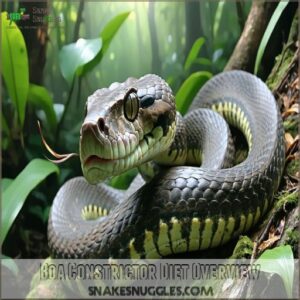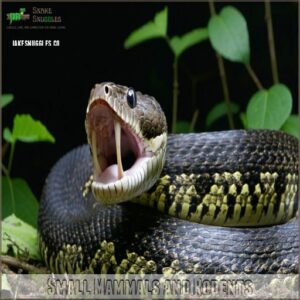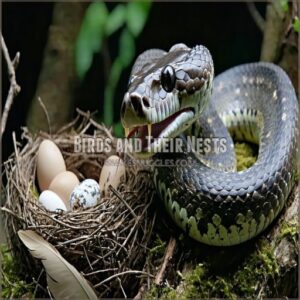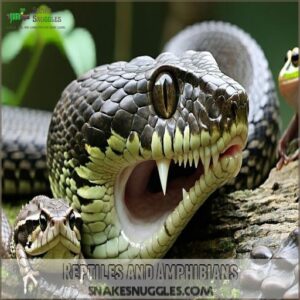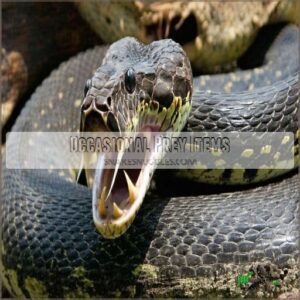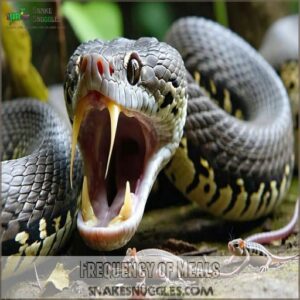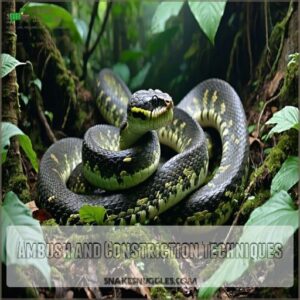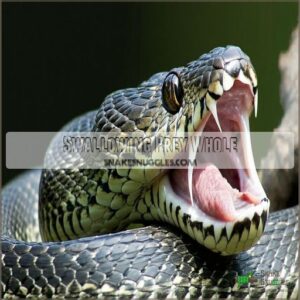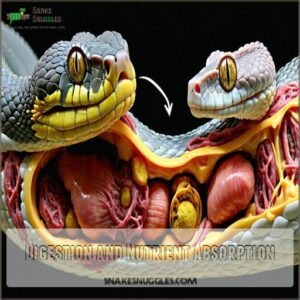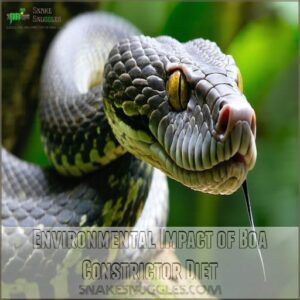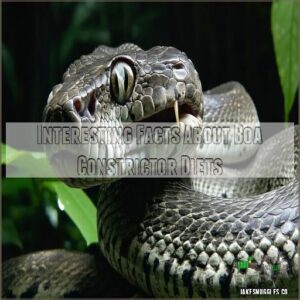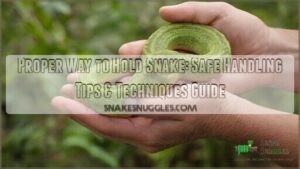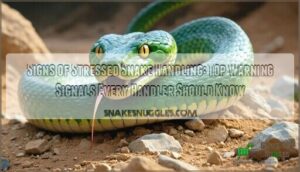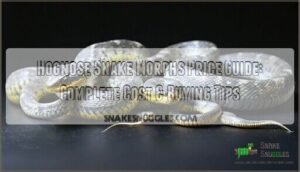This site is supported by our readers. We may earn a commission, at no cost to you, if you purchase through links.
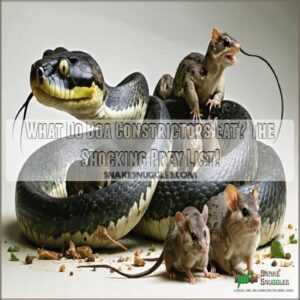 When you’re wondering what boa constrictors eat, you’ll be surprised by their diverse menu.
When you’re wondering what boa constrictors eat, you’ll be surprised by their diverse menu.
These cunning predators feast on small mammals like rodents, bats, and opossums, while also targeting birds, their eggs, and chicks. They’re not picky eaters and will even snack on reptiles and amphibians, including lizards and snakes.
Using their incredible heat-sensing pits and muscular strength, they’ll silently stalk their prey before launching a lightning-fast attack. With jaw-dropping flexibility, they can swallow prey whole, sometimes waiting weeks between meals.
By regulating prey populations, these incredible hunters play a significant role in maintaining ecosystem balance.
Table Of Contents
- Key Takeaways
- Boa Constrictor Diet Overview
- Types of Prey for Boa Constrictors
- Boa Constrictor Eating Habits
- Environmental Impact of Boa Constrictor Diet
- Interesting Facts About Boa Constrictor Diets
- Frequently Asked Questions (FAQs)
- What do boa constrictors eat?
- Do boa constrictors eat lizards?
- Do boa constrictors eat bats?
- Can boa constrictors eat frozen prey?
- What should a boa eat?
- Do boa constrictors eat frogs?
- What do you feed a pet boa?
- How often does a boa constrictor eat?
- Do boa constrictors like to be held?
- Can boa constrictors eat fruit?
- Conclusion
Key Takeaways
- Boa constrictors eat a wide range of prey, including small mammals like rodents and opossums, birds (and their eggs), reptiles, and occasionally amphibians.
- They use heat-sensing pits, powerful constriction, and flexible jaws to hunt and swallow prey whole with precision.
- In the wild, they play a vital role in controlling prey populations, keeping ecosystems balanced and preventing species overpopulation.
- When kept as pets, they thrive on a diet of appropriately sized, pre-killed rodents and require careful monitoring of their feeding schedules for optimal health.
Boa Constrictor Diet Overview
Ever wondered what mysterious creatures lurk on a boa constrictor’s menu?
These incredible predators have a diverse diet that’ll surprise you, ranging from small mammals and birds to some unexpected prey that’ll make your jaw drop.
Main Prey Items in The Wild
In the lush tropical forests, boa constrictors feast on a diverse menu that keeps forest ecosystems buzzing.
Their wild prey diversity spans multiple categories of forest inhabitants:
- Nimble rodents scurrying through undergrowth
- Small mammals darting between tree roots
- Unsuspecting birds nestled in forest canopies
- Occasional reptilian wanderers crossing snake territories
Boas can go weeks without eating after devouring large prey, being opportunistic carnivores.
These skilled predators maintain delicate food web balances with surgical precision.
Hunting and Eating Habits
Ever wondered how boa constrictors turn prey into dinner?
These masters of stealth strike with lightning precision, using powerful ambush tactics that would make any predator proud.
Their hunting frequency depends on prey size, while sensory roles help them locate unsuspecting victims in the dark.
| Hunting Skill | Prey Detection | Success Rate |
|---|---|---|
| Camouflage | Heat Sensing | 85% |
| Silent Stalk | Vibration Cues | 90% |
| Patient Wait | Scent Tracking | 95% |
| Quick Strike | Visual Cues | 80% |
| Constriction | Sound Mapping | 88% |
Role of Boa Constrictors in Ecosystems
Imagine nature’s intricate tapestry, where boa constrictors weave their ecological magic.
These carnivorous predators help maintain habitat balance by controlling prey populations.
By regulating rodent and small mammal numbers, they prevent ecosystem disruption. Their feeding habits guarantee that no single species overwhelms the delicate predator-prey dynamics, making them unsung heroes of conservation efforts.
Adaptations for Efficient Hunting
Boa constrictors reign supreme as ambush predators, wielding jaw-dropping hunting adaptations.
Their muscular strength and heat-sensing pits turn them into precision killing machines.
With powerfeeding capabilities, they detect warm prey through specialized sensory organs, striking silently. Their constriction power crushes victims instantly, making them nature’s most efficient carnivorous hunters of the tropical ecosystem. Ambush predators and precision killing machines.
Types of Prey for Boa Constrictors
If you’re curious about the diet of boa constrictors, you’ll be amazed at their diverse prey selection.
These remarkable predators can devour an impressive range of animals, from tiny rodents to unsuspecting birds and even small mammals that might roam too close.
Small Mammals and Rodents
Nature’s ultimate rodent hunters, these serpents are walking stomachs with killer instincts.
Their prey selection depends on size, availability, and nutritional needs. Rats scurrying through burrows, squirrels perched in trees, and unsuspecting opossums all fall prey to these master predators.
From tiny mice to plump rabbits, boa constrictors have a menu that reads like a small mammal’s worst nightmare.
With strategic ambush techniques and jaw-dropping constriction skills, boas transform tiny mammals into their next gourmet meal, maintaining nature’s delicate balance one bite at a time.
As part of their whole prey diet, these animals consume fur, feathers, and bones, which provide essential nutrients for their survival.
Birds and Their Nests
Slithering silent predators, boa constrictors exploit avian vulnerabilities during nest predation.
They leverage birds’ predictable nesting patterns, targeting fragile eggs and defenseless chicks.
By mapping nest locations and timing their strikes precisely, these skilled hunters transform bird sanctuaries into hunting grounds, consuming entire broods with calculated precision in their relentless quest for survival. Boa constrictors are skilled hunters.
Reptiles and Amphibians
Reptile prey choices for boa constrictors span multiple fascinating species, making their diet incredibly diverse. These ambush hunters target lizards, turtles, and even venomous snakes with calculated precision.
Their incredible hunting strategy involves remarkable adaptations:
- Muscular bodies enable powerful constriction of diverse reptilian prey
- Flexible jaw structure facilitates whole-animal consumption
- Sensory adaptations track potential cold-blooded targets with exceptional accuracy
Young boas also eat small birds and lizards as part of their varied and opportunistic feeding habits.
Amphibian consumption completes their opportunistic feeding repertoire, highlighting their adaptable predatory nature.
Occasional Prey Items
After exploring reptilian snacks, let’s uncover the wild menu of boa constrictors.
These serpentine opportunists occasionally feast on carrion, large mammals, and even unexpected prey like domestic livestock.
Check out their jaw-dropping dietary flexibility:
| Prey Type | Frequency | Significance |
|---|---|---|
| Carrion | Rare | Survival Strategy |
| Large Mammals | Occasional | Opportunistic Feeding |
| Livestock | Uncommon | Dietary Adaptation |
Boa Constrictor Eating Habits
You’re about to discover the fascinating world of boa constrictor eating habits.
These remarkable predators transform hunting into an art of survival.
Prepare to be amazed by their unique ability to swallow prey whole and their incredible techniques.
Their ambush and constriction make them one of nature’s most efficient hunters.
Frequency of Meals
Wondering how often your boa constrictor chows down? Adult boas typically feast every 7-10 days, while younger snakes demand more frequent meals.
Maintaining a feeding log, like the one suggested in a Boa Constrictor Feeding Chart, helps monitor feeding patterns and adjust schedules.
Here’s a quick feeding survival guide:
- Track individual snake’s metabolic needs
- Match prey size to snake’s body width
- Adjust feeding frequency with growth stages
- Monitor digestive rates carefully
Your boa’s meal timing is a delicate dance of nutrition and growth, balancing hunger with strategic feeding schedules.
Ambush and Constriction Techniques
Ever wondered how boa constrictors transform from lazy loungers to lightning-fast hunters?
These carnivorous ambush predators leverage incredible sensory perception to strike with jaw-dropping precision.
Camouflaged near rocks or tree branches, they wait silently, tracking prey through heat sensors and acute smell.
Their hunting strategies turn them into nature’s most patient and deadly predators.
Swallowing Prey Whole
How do boa constrictors manage to swallow prey much larger than their head?
These incredible serpents pull off this feat through remarkable physical adaptations.
Their secret weapons include:
- Incredible jaw flexibility that allows them to unhinge and stretch their mouth
- Expandable esophagus capable of accommodating prey twice its normal size
- Unique skeletal structure enabling rib disarticulation for massive meal consumption
Digestion and Nutrient Absorption
Every digestive journey begins with stomach acids breaking down swallowed prey.
Your boa constrictor’s metabolic magic transforms whole meals into essential nutrients through complex absorption processes.
Temperature and prey size dramatically influence this efficiency, with precise enzyme interactions determining how effectively each meal fuels the snake’s incredible metabolic needs. Proper handling and presentation of prey can also aid digestion, as it helps to mimic natural hunting behaviors. This efficiency is crucial for boa constrictors.
Environmental Impact of Boa Constrictor Diet
You’ll be surprised how boa constrictors play a vital role in maintaining ecosystem balance through their unique predatory habits.
By controlling prey populations and serving as both predator and prey, these remarkable serpents contribute to the intricate web of life in their tropical habitats.
Population Control of Prey Species
Boa constrictors wield remarkable power in shaping ecosystem dynamics through their predatory prowess. These serpentine guardians maintain delicate population balances across tropical landscapes. Their hunting strategies trigger fascinating ripple effects in prey communities.
- Rodent populations shrink under their calculated strikes
- Bird nesting patterns transform with snake presence
- Reptile and amphibian numbers remain naturally controlled
- Prey species develop strategic survival adaptations
Scientific observations reveal boa constrictors as nature’s precision population managers. By selectively targeting specific prey, they prevent unchecked reproductive explosions that could disrupt ecological harmony. Their predation isn’t just about survival—it’s a sophisticated dance of population regulation, ensuring each species maintains its critical role in the intricate web of life.
Ecosystem Balance and Stability
Ecological harmony hinges on predators like boa constrictors maintaining a delicate balance.
By regulating prey populations through strategic hunting, these serpents trigger trophic cascades that reshape ecosystem dynamics.
Their precise niche partitioning influences species diversity, controlling rodent and small mammal numbers while ensuring habitat stability through calculated population regulation. Boa constrictors play a crucial role in ecosystem balance.
Additionally, boa constrictors adapt their snake hunting techniques to prey behavior and environmental factors, ensuring their ecological role remains effective. Predator-prey dynamics are key to ecological harmony.
Potential Threats to Boa Constrictor Populations
When ecosystems wobble, boa constrictors face mounting challenges.
Their survival hinges on delicate balances disrupted by:
- Shrinking habitats pushing them into human territories
- Climate shifts reducing prey availability
- Invasive species introducing deadly diseases
These threats squeeze their populations, forcing boas to adapt or perish in a rapidly changing world where survival means outsmarting environmental pressures.
Conservation Efforts and Management
Rarely do conservation efforts pack as much punch as those protecting boa constrictors.
By championing habitat protection and population monitoring, we’re tackling human-wildlife conflict head-on.
Captive breeding programs and sustainable tourism help wild boa constrictor populations thrive, ensuring these remarkable predators continue their role in maintaining ecosystem balance.
Effective boa care practices also play a significant part in supporting conservation efforts.
Interesting Facts About Boa Constrictor Diets
You might be surprised to discover the remarkable dietary habits of boa constrictors.
These incredible predators can consume prey almost as large as themselves.
boa constrictors use specialized adaptations that make them one of nature’s most efficient and fascinating hunters.
Seasonal Variations in Prey Availability
Boa constrictors dance to nature’s rhythm, adapting their hunting strategies with prey abundance and seasonal scarcity.
Their survival depends on understanding subtle environmental cues:
- Tracking prey movement through tropical landscapes
- Adjusting hunting zones based on seasonal shifts
- Exploiting temporary food concentrations
- Analyzing micro-habitat changes
- Responding to climate-driven prey migrations
As migration patterns shift, these remarkable predators navigate changing ecosystems with remarkable precision.
Boa Constrictor Feeding in Captivity
Master your pet boa’s diet with precision and care. Select prey carefully, sizing items 1-1.5 times the snake’s diameter. Feed juveniles every 7-10 days, adjusting for age and growth.
To support a balanced diet, maintain a 2:1 or 3:1 calcium-to-phosphorus ratio.
Craft a comfortable habitat with strategic humidity and temperature gradients.
Prioritize nutritional balance and safe handling to safeguard your slithery companion thrives in captivity, transforming feeding time from a challenge into a seamless, nurturing ritual.
Unique Feeding Behaviors and Adaptations
When you’ve watched a captive boa’s feeding routine, you’ll marvel at their wild hunting prowess.
Equipped with extraordinary sensory organs and jaw mechanics, these serpents detect prey with precision.
Their metabolic rate allows them to consume larger prey sizes efficiently, while their unique digestion speed transforms entire victims into nutrition—a remarkable example of nature’s impressive predatory design.
Frequently Asked Questions (FAQs)
What do boa constrictors eat?
Slithering, hunting, consuming—boa constrictors feast on small mammals, birds, and reptiles.
You’ll find them ambushing rodents, bats, and quail.
swallowing prey whole with their impressive jaws, showcasing nature’s remarkable predatory prowess.
Do boa constrictors eat lizards?
Yes, boa constrictors devour lizards as part of their diverse diet.
These skilled hunters track and constrict small reptiles with precision, making lizards a tasty meal in their carnivorous menu of tropical forest prey.
Do boa constrictors eat bats?
Like nocturnal hunters prowling the shadows, boa constrictors definitely snatch bats during their hunting expeditions.
They’ll ambush these flying mammals in caves or forest canopies, demonstrating their versatile predatory skills with remarkable precision.
Can boa constrictors eat frozen prey?
You can feed boa constrictors frozen prey safely.
Thaw the food carefully, warm it to body temperature, and use tongs to serve.
Always discard uneaten prey to maintain your snake’s health and prevent contamination.
What should a boa eat?
Turns out your boa’s menu isn’t fancy—just mice, rats, birds, or small mammals.
They thrive on whole prey for essential nutrients.
Feed young boas weekly, adults less often.
Frozen prey works; just thaw it properly.
Do boa constrictors eat frogs?
Boa constrictors typically don’t eat frogs, as their diet focuses on mammals, birds, and reptiles like lizards.
However, in rare cases, they may consume small amphibians if other prey isn’t available in their habitat.
What do you feed a pet boa?
Think of feeding your boa like preparing a specialized meal; offer rats or mice, ideally pre-killed and appropriately sized.
Feed younger boas every 5-7 days and adults every 10-15 days for the best health.
How often does a boa constrictor eat?
You’ll feed young boas every 5 to 7 days, as they grow quickly.
Adults eat every 10 to 15 days since their metabolism is slower.
Stick to appropriately sized prey to keep them healthy.
Do boa constrictors like to be held?
Boa constrictors don’t crave being held but tolerate it if they’re calm, used to handling, and feel safe.
Always support their body fully, avoid sudden movements, and watch for stress signs like hissing or writhing.
Can boa constrictors eat fruit?
Offering fruit to a boa constrictor is like trying to feed salad to a lion.
These carnivorous snakes only eat whole prey like mammals, birds, or reptiles.
They rely solely on meat for survival and nutrition.
Conclusion
It’s ironic that boa constrictors, with their slow movements, can take down such a wide variety of prey.
From small mammals and birds to reptiles and amphibians, their diet is as diverse as it’s essential for balancing ecosystems.
Whether they’re regulating prey populations or showcasing expert hunting skills, these snakes play a significant ecological role. boa constrictors eat?
So, next time someone asks, "What do" you’ll know their menu is anything but simple.

